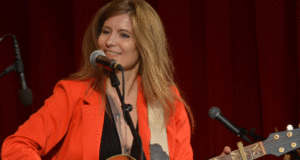The genre uses nature, landscapes, and traveling, as part of the music vocabulary to understand the love themes in its song lyrics. It is said in traditional folklore storytelling that certain nature spots have a story to tell, and will affect people who go there; Like how it happens when one passes the mysterious Medicine Wheel in Wyoming. This and other tales are inspiration for the music genre. Nordic Americana came to see its light in a studio in Berlin, after I traveled through the US on a road trip.
 I took the Amtrak train from New York to Arizona, then drove from Flagstaff, AZ, up through Utah, The Canyons, to Seattle, then back through Idao, Wyoming, South Dakota, and the Badlands, then back NYC. I think I saw half of America in just five weeks. It changed my whole perspective on the American people, and city life with its conceptualized culture, to nature and how it contains the concept of living life with nature as the culture with its imagery and poetry.
I took the Amtrak train from New York to Arizona, then drove from Flagstaff, AZ, up through Utah, The Canyons, to Seattle, then back through Idao, Wyoming, South Dakota, and the Badlands, then back NYC. I think I saw half of America in just five weeks. It changed my whole perspective on the American people, and city life with its conceptualized culture, to nature and how it contains the concept of living life with nature as the culture with its imagery and poetry.
German producer, Brio Taliaferro, who would help me put my album together, said “Nordic Americana is something we created in the studio. I thought the term sounded cooler than ‘Scandinavian Americana’. The term Nordic is used quite a lot for Scandinavian music. There is a genre called Nordic Folk. Mixing unrelated styles is the coolest thing since the invention of music. Without this, we wouldn’t have half the styles around today, not even rock and roll,” he said. (Brio Taliaferro is known for his work with Sugarebabes, “Easy,” James Blunt, and the Moby remix, Dico a.o.) “So when we recorded the Dry Wood EP, I thought we needed a description for this new style,” Brio said.
Nordic Americana is based more on the lyrics, than dancing. The storytelling is essential, however I adapted the concept of bringing spontaneous dance into my performances.
Americana, as defined by the Americana Music Association (AMA), is “contemporary music that incorporates elements of various mostly acoustic American roots music styles, including country, roots rock, folk, gospel and bluegrass, resulting in a distinctive roots-oriented sound that lives in a world apart from the pure forms of the genres upon which it may draw. While acoustic instruments are often present and vital, Americana also often uses a full electric band.”
Old traditional Folk music often is based on oral singing with no notes or sheet music, and only acoustic instruments. It is the same tradition for Nordic Americana. It is based on the spontaneous aesthetic interpretation of music. Growing up with the concept of a tradition in Denmark with community songs called, Højskolesange and Psalms, my mother would hear Joan Baez along with British ballads. Our young girl ears would tune in to the melodically sung verses and go along on the journey with her.
The intonation in English is softer than the Danish pronunciation, where hard consonants dominate the music tapestry. Danish songs also often seem to be less painful emotionally. Thoughts are not so painfully and deeply expressed, but rather have a more poetic nerve than does the mellow British or bluesy American genre.
Less Rooted
Traditionally, Americana music is normally deeply rooted in the American soulful history, from slaves in the cotton fields singing about a hard life, and later those bluesy tones ended up in a New York jazz club in Harlem. The impressions from a city life is combined with the longing for nature as the medicine for true happiness, revelations and realization as ones true purpose, based on a purified soul. Danish songs have traditionally been more rooted in a societal, we-go-together, concept.
Where roots and blues music in Americana has expressed the deepest pain and culture for the individual under various hard conditions for a long time; as an example, only since the 1970s, has the Danish society developed the idea of the Feminist movement, whereby female Danish singers were popularized as singer-songwriters. Trille was one the of the first to sing sad political themes that could remind one of the Americana style. She sang of the painful sadness of a single mother, factory worker living a miserable life, poor alcoholic, on a hamster wheel.
Politically Charged
The Danish songwriters didn’t become political and emotional until the 1980s. In the new millennium though, Danish trad-folk (traditional folk) is having a revival. Danish songwriters and orchestras have begun to re-explore the Nordic Folk genre: the old folk tradition. Folk bands play at events where people still dance to their folk songs. Old folk songs have been reinvented. Not so many align with the English language, but now its coming back with many singing in Dutch. By once again mixing new ideas with old styles, we have coined a new flavor with my music we lovingly call Nordic Americana.
By Mette Kirkegaard
Listen to Mette’s interview on the Americana Music Profiles podcast!
 Americana Music Magazine – Bluegrass, Roots, Folk, Blues, and Old-Time
Americana Music Magazine – Bluegrass, Roots, Folk, Blues, and Old-Time